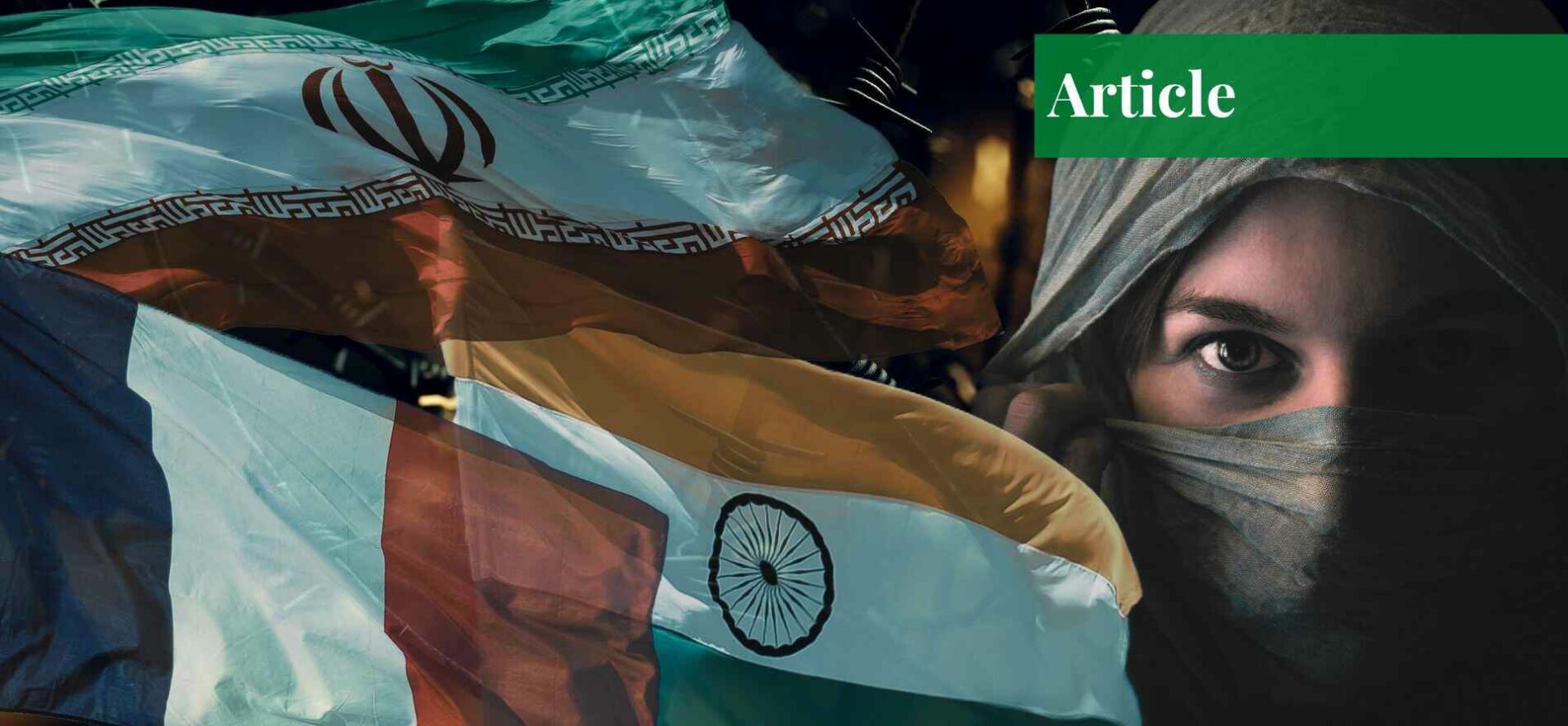The Practice of Veiling
The word “veil” in English is described as a piece of apparel composed of cloth that sometimes conceals a woman’s entire face and hair. To understand the politics of the veil, one must bear in mind that it is neither a practice that is exclusive to Muslims nor anything that Islam invented. Instead, veiling is a custom that predates Islam’s creation in the early seventh century by thousands of years, both within and outside of the Middle East.
Veiling has been a tradition linked with “women, men, holy places, and items” throughout history and the world. Many religions mandate visitors to places of worship cover their heads. Mother Mary is also portrayed with her head veiled, as do several orders of nuns. In mosques, Muslim males are covered in skullcaps. It is also required to cover one’s head in gurdwaras and Hindu temples as a sign of reverence for God.
Women in North India are instructed to cover their heads as a sign of respect for their elders. The diversified reasons for veiling illustrate the differences in how Muslims choose to cover themselves and show that the hijab, or veil in Arabic, has no set meaning and definitely no unique designs, colors, or qualities. Veiling has always signified different things to different individuals in different places at distinct times.

The theological and political explanations of the veil are frequently not believed to constitute the entirety of any discussion of veiling. While religion and politics undoubtedly contribute to the reasons why some Muslim women choose to veil their faces, they are insufficient on their own to explain the ups and downs of veiling customs over time or the influence that fashion, the economy, or unique situations have on a woman’s decision to cover her face.
Additionally, they ignore the veiling’s considerably more nuanced contemporary significance in cultures with a majority of Muslims and in Europe and the United States. Moreover, they even silence Muslim women’s own voices of resistance and their fights against stereotypes of the “veiled Muslim lady” as well as against orthodox Islamist governments’ powers of political manipulation.
The Veil In India: Religion and Region
Women from India frequently cover their heads. According to a Pew Research Center poll done in 2019–2020, 61% of Indian women said they continue the tradition of covering their heads outside of their homes. That includes the majority of Hindu women (59%), as well as almost similar percentages of Muslim (89%) and Sikh (86%) women, despite the fact that religious groupings might differ greatly in terms of the specific headgear worn.
According to the 2011 census, India’s adult population is 81% Hindu and 13% Muslim. The majority of the remaining 6% is made up of Christians, Sikhs, Buddhists, and Jains. The practice is particularly widespread in the Northern, Central, and Eastern areas of the nation, where the majority of the population speaks Hindi. Nine out of ten women said they cover their heads in public in Bihar, Madhya Pradesh, and Rajasthan.
In sharp contrast, fewer women in the South, including only 16% in Tamil Nadu, said they wear head coverings publicly. Hindu women are mostly responsible for these geographical variations, while Muslim women often continue to cover their hair publicly no matter where they live. In particular, this creates significant divisions among Muslims and Hindus in the South.
Compared to 22% of Hindu women, 83% of Muslim women in the South claim to cover their heads. A similar proportion of Muslim (85%) and Hindu (82%) women in the Northern area, however, claim to cover their heads in public. The state of Karnataka stands out in the South for having a disproportionately high proportion of women who cover their heads.
In Karnataka, 44 percent of women report wearing one, against 26 percent in nearby Andhra Pradesh, 29 percent in Telangana, and even lower in Kerala (17 percent) and Tamil Nadu (16 percent). Seventy-one percent of Muslim women in Karnataka claim to cover their heads, compared to four percent of Hindu women.
In February 2022, international media attention was drawn to demonstrations against Muslim head coverings in Indian schools. Hijabs were prohibited from being worn in classrooms at a high school in the southern state of Karnataka, which sparked protests that later expanded to other regions.
The validity of the school closure was under consideration by the Karnataka High Court, which shortly provided a decision in the month of March that hijab-wearing was not an important religious practice in Islam and ruled that fair limits must be placed on the right to follow one’s religion under Article 25 of the Constitution.
Two Muslim girls from the Government Pre-University College of Girls in Udupi were denied access to their final test in April after they contested the hijab prohibition in Karnataka’s academic institutions. One of them even tweeted to the chief minister, pleading with him to allow them to take the test while wearing the hijab and “to save their futures from becoming damaged.“
The Veil in France: Controversy and Colonisation
Muslim veils were among the several religious symbols that were prohibited from being worn in French school systems in 2004. The nation also outlawed full-face coverings like niqabs in 2010 in public areas including streets, playgrounds, and public transit, making it the first nation in Europe to do so. The government even conducted a campaign that said, with pride, “the Republic is lived with an exposed face.”
When the coronavirus spread in 2020, this view acquired a fresh irony when France imposed masks to be used in public areas while continuing to prohibit Muslim facial coverings. The debate over an amendment voted by the French Senate in January 2021 that would forbid females under the age of 18 from donning the veil in public follows the uproar around one woman’s decision to cover her head.
It was tabled alongside modifications that would also forbid women from wearing headscarves on their children’s school excursions and would outlaw the “burkini,” a full-body swimsuit, as part of a planned “anti-separatism” measure.
Since France is the country with the highest Muslim population in West Europe and has seen an upsurge in discrimination as a result of recent terrorist attacks by Islamic extremists and the increase of far-right politics, some French politicians supported the amendment concerning the veil as a reaffirmation of the nation’s compliance with secularism.
However, others criticized it as yet another example of an aspect of a dirty strain of Islamophobia in the nation. In contrast, a government study from the same year discovered that 42% of Muslims (other studies put the number at 58%) reported experiencing discrimination due to their religion, that figure rose to 60% for women who wore a headscarf.
According to one study from 2019, 44.6% of the state believed that Muslims posed a risk to the French national identity. This perception evolved over time as French politicians opined that laws limiting religious symbolism are in the interest of women’s empowerment and the safety of the public. The Somali-Norwegian model Rawdah Mohamed started the hashtag #HandsOffMyHijab, which was used as a rallying cry to reject the amendment.
Rawdah used the term in a now-popular Instagram post to call out the potential ban. Since then, others, like Olympic fencer Ibtihaj Muhammad and US lawmaker Ilhan Omar, have backed it. This attention to Muslim headscarves and the women who wear them in France dates back to the country’s colonial past in North Africa and the Middle East, notably in Algeria, as per scholars.
“Banning the hijab is about colonialism,” Alia Al-Saji, an associate professor of philosophy at McGill University, tells TIME. “French colonisation of Muslim countries was often about controlling and managing populations that were of diverse religions.” The Conquest of 1830 marked the commencement of French colonization in Algeria, which was defined by settler colonialism, brutal massacres, and a series of fluid rules known as the “indigénat,” which, among other things, decided who might be a French citizen.
Al-Saji points out that this legislation had a significant impact on highlighting the differences between Algeria’s Muslim majority. For instance, the Cremieux Decree in 1870 recognized Jewish Algerian natives as French citizens, but Muslim Algerian natives were not qualified for French citizenship except if they disavowed their culture, religion and accepted a French identity.
A number of open-air dedication events were planned in 1958 during the Algerian War of Independence. Algerian women discarded their haiks (the customary wraps worn by North African women) at these rituals or had them taken off by European women, before either tossing them to the floor or setting them afire. Later, lectures in favor of France and the liberation of Muslim women were frequently delivered.
Although these widely reported events were presented as places where Muslim women might be empowered, other interpretations of this history paint a different picture. According to Neil MacMaster’s book Burning the Veil: The Algerian War and the ‘Emancipation’ of Muslim Women,1954–1962, a number of women who participated in these commemorations were extremely underprivileged, selected from high schools, or in some cases, under duress with provocations to their safety and the security of their families.
In Algeria Unveiled, Frantz Fanon argues that the veil may be a tactic of anti-colonial struggle and a method to deny oppressors accessibility, even going so far as to refer to it as a “bone of contention in a grandiose struggle.” The veil evolved as a practical instrument of resistance during the conflict. Some female National Liberation Front freedom fighters utilised haiks to hide weapons and sensitive information; once this strategy was uncovered, they took advantage of the unveiling by dressing in European attire to evade French detection.
The Veil In Iran: Raison D’Etre and Revolution
Iranian women who were born before the monarchy was overthrown in 1979 recall living in a society where women had a great deal of freedom when it came to dressing. The movement that overthrew the Shah included participants of all political and religious persuasions, but ultimately, it was Ayatollah Ruhollah Khomeini and his adherents who took control and established an Islamic state ruled by Shiite clerics.
Asserting that “the women who played a role in the revolution were and are women who wear modest clothes,” Ayatollah Ruhollah Khomeini told Italian journalist Oriana Fallaci in February 1979: “These coquettish women, who wear makeup and put their necks, hair, and bodies on display in the streets, did not fight the Shah. They have done nothing righteous. They do not know how to be useful, neither to society, nor politically or vocationally. And the reason is that they distract and anger people by exposing themselves.”
Negar Mottahedeh, a political scientist, tells DW that “many women rejected this.” Her most recent book, Whisper Tapes, expands on the findings of feminist journalist Kate Millet of the US, who visited Iran immediately after the 1979 revolution. In her essay, Mottahedeh mentions one of the catchphrases from the post-revolutionary women’s movement: “We did not have a revolution to take a step backwards.” It describes how “female attorneys, students, and workers convened to debate their rights.”
However, women’s rights received little attention from Khomeini and his allies. They believe that Iranian women should be the complete antithesis of the liberated, liberal women in the West. Along with removing Iran from decades of US politics and economic sway, the revolutionaries also sought to advance Islamic culture with the veil. The veil, which represents Iran’s resolutely anti-Western politics and way of life, became a defining feature of this new, old order.
In her 2007 article Women and Politics in Iran: Veiling, Unveiling, and Reveiling, US political scientist Hamideh Sedghi claims that “The Islamic Revolution turned into a sexual counter-revolution, a war over women’s sexuality.” Thus, sexuality has evolved into a highly divisive topic with an overtly anti-Western undertone. Wear a veil or we’ll punch your head, was one of the catchphrases that circulated in 1979. The other was “Death to the Unveiled.”
Parliament ruled in 1983 that women who don’t cover their hair in public should get 74 lashes as punishment. Since 1995, women who are not covered up may also be detained for up to 60 days. The “Gasht-e Ershad” (Guidance Patrols) morality police are in charge of, among other things, making sure ladies dress according to what the authorities consider to be “appropriate.”
Officers have the authority to stop women and determine if their hair is showing excessively, whether their overcoats and pants are too short or tight, or whether they are sporting excessive amounts of makeup. Fines, jail time, or public whipping are possible penalties for breaking the regulations.
In 2014, Iranian women started posting pictures and videos online, showing themselves openly disobeying the hijab restrictions as part of a “My Stealthy Freedom” online protest campaign. Other initiatives, such as “White Wednesdays” and “Girls of Revolution Street,” have subsequently been influenced by it. The mandatory veil, however, which is at the core of Iran’s cleric-led state’s character, is being attacked with venom by the new wave.
Women must cover up in public in the Islamic Republic of Iran, which includes donning a “hijab,” or headscarf, that is meant to entirely conceal hair. Many Iranian women, particularly in large cities, have long engaged in a game of cat and mouse, with newer generations donning loose scarves and attire that pushes the limits of traditional clothing. Tragically, that game could be lost.
Mahsa Amini, a 22-year-old woman who was detained by morality police in Tehran’s capital city, passed away on 16 September, 2022 while she was being held. Her passing precipitated almost two weeks of widespread protest that expanded to Iran’s regions and mobilised students, professionals from the middle class, and members of the working class.
According to reports on Iranian official television, at least 41 police officers and 13 people lost their lives, according to official government claims compiled by the Associated Press, while more than 1,400 protesters have been detained. A young woman in Tehran who claimed to have consistently taken part in the capital city’s rallies claimed that the size of demonstrations had significantly decreased as a result of the security forces’ brutal response.
Conclusion
The states of India, France, and Iran create a triangle where the subject of the veil has been historically and currently tossed around in politics, trapped and terrorised to an immense level. Although the three corners of the triangle inherit a diverging lineage on this specific matter, what they have in common is the display of their measures taken in good faith and for better governance.
The women of these states suffer continuously from being subjected to enormous violations of their bodily autonomy; the reduction of their identity within a certain paradigm and the threat to their agency. The practice of veiling should revolve around consent in which a person should have the authority to adopt or reject the practice of veiling as per personal choice rather than falling prey to the control of the state and government.
However, the recent resilient movements, protests, and social media trends exhibit how women are determined and courageously brave to demand their rights be released from the shackles of oppressive laws and measures. In India and France, the ban on the veil serves as a deprivation of one’s identity and freedom to practise their religion. In Iran, the veil is unveiled as a tool for employing oppression and deducting lives to a set pattern decided by the state.
Therefore, the bonfires of veils are as reasonable as the protests for the allowance of veiling because, under both circumstances, women are asking for a termination of their body policing and freedom in terms of their rights and choices, voicing out the tyranny of the state and marking their disapproval.
As Arundhuti Roy said, “There’s really no such thing as the ‘voiceless’. There are only the deliberately silenced or the preferably unheard.” This time, the women are insistent on being heard, understood, and cured of their agony.
If you want to submit your articles/research papers/book reviews, please check the Submissions page.
The views and opinions expressed in this article/paper are the author’s own and do not necessarily reflect the editorial position of Paradigm Shift.



















